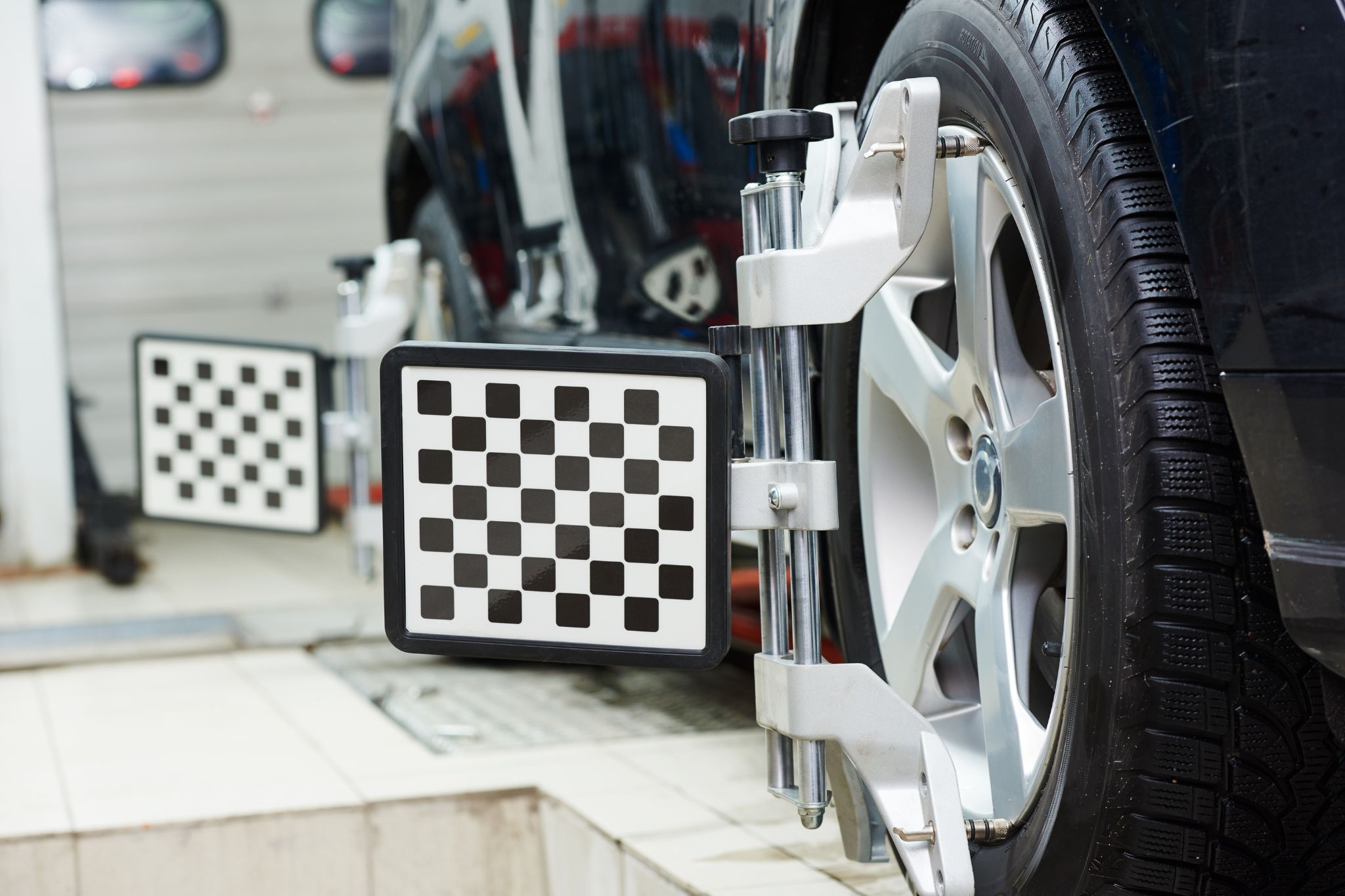Are your car wheels unaligned? Are you worried about your car’s safety on the road? With Hyundai’s wheel alignment service, you can now drive confidently knowing that all four of your wheels are properly aligned – giving you maximum control and comfort.
Make sure your car runs at its peak performance by getting the Hyundai wheel alignment today!
With a vehicle as innovative and technologically advanced as a Hyundai, maintaining proper wheel alignment is crucial. A well-aligned set of wheels not only enhances safety and driver control but also ensures optimal performance and fuel efficiency.
So, let’s delve deeper into the world of Hyundai wheel alignment and discover the essential aspects that every Hyundai owner should know.
When it comes to Hyundai wheel alignment, precision is key. Properly aligned wheels guarantee a smooth and balanced ride, reducing tire wear and extending the lifespan of your tires. In addition, it minimizes vibrations and maximizes traction, allowing for better handling on all types of road surfaces.
This is especially important for Hyundai vehicles since their cutting-edge features are designed to deliver exceptional comfort and handling capabilities.
One significant aspect of Hyundai wheel alignment is camber adjustment. Camber refers to the vertical angle of the wheels when viewed from the front or rear of the vehicle.
A negative camber tilts the top of the wheel inward, while a positive camber tilts it outward. Achieving the correct camber alignment is vital in order to maintain even tire contact with the road surface, ensuring optimal grip and stability during cornering.
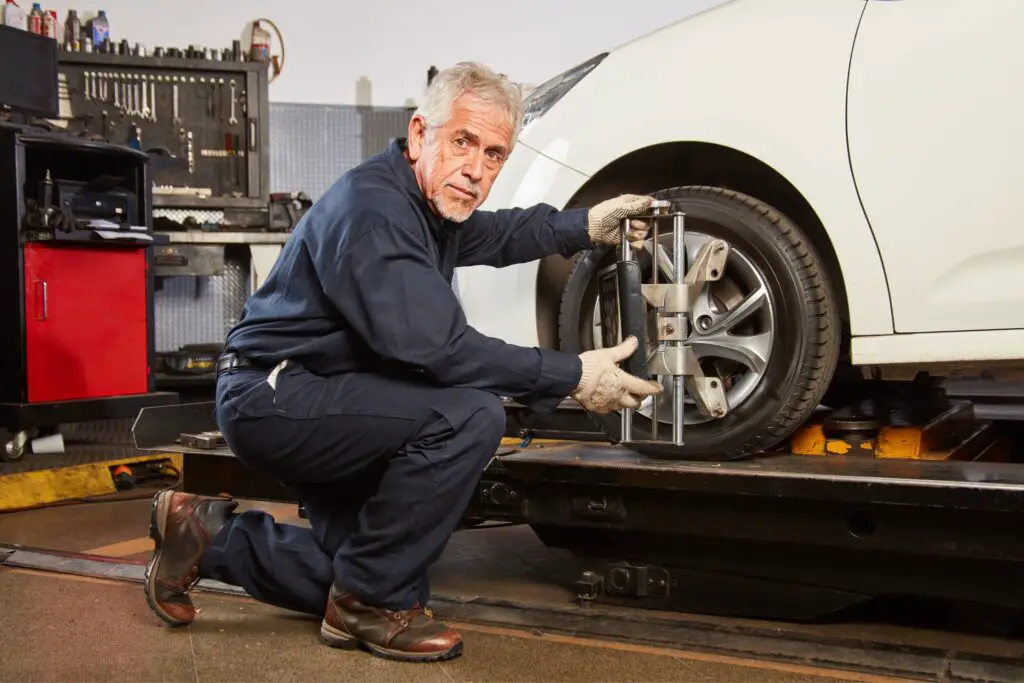

Furthermore, toe adjustment plays a crucial role in Hyundai wheel alignment. Toe refers to the horizontal angle at which your wheels point inward or outward when viewed from above. Improper toe settings can lead to excessive tire wear, steering instability, and compromised fuel efficiency. Therefore, regular maintenance of toe alignment is essential to keep your Hyundai performing at its best.
Now that you are aware of these crucial details surrounding Hyundai wheel alignment, make sure not to overlook this aspect of maintenance for your beloved vehicle. By scheduling routine check-ups and alignments with certified professionals who understand the specific requirements of your Hyundai model, you can ensure peaceful rides filled with confidence and safety.
Remember that neglecting proper wheel alignment may result in unnecessary expenses due to premature tire replacement or even compromising your safety on the road.
So, seize the opportunity to maintain your Hyundai’s performance and longevity by prioritizing regular wheel alignment. Don’t miss out on the benefits that come with a well-aligned set of wheels – book your appointment today and experience the difference it makes in your driving experience.
Get your Hyundai’s wheels in perfect alignment because life’s too short for crooked rides.
Hyundai Wheel Alignment
Hyundai Wheel Alignment ensures that your vehicle’s wheels are properly aligned, promoting better handling, improved fuel efficiency, and longer tire life.
Here is a breakdown of the different aspects of Hyundai Wheel Alignment:
Alignment Parameters:
- Camber: The inward or outward tilt of the wheel when viewed from the front. Incorrect camber can lead to uneven tire wear.
- Toe: The angle at which the tires point inward or outward when viewed from above. Incorrect toe alignment can cause excessive tire wear and poor steering response.
- Caster: The forward or backward tilt of the steering axis when viewed from the side. Incorrect caster alignment can affect stability and steering control.
Properly aligned wheels offer benefits such as:
- Improved Fuel Efficiency: Proper alignment reduces rolling resistance, allowing your vehicle to move more efficiently and consume less fuel.
- Enhanced Handling and Safety: Correctly aligned wheels provide better control, especially during turns and sudden maneuvers.
- Extended Tire Life: Uneven tire wear due to misalignment can cause premature tire replacement. Proper alignment helps ensure even tread wear for longer-lasting tires.
- Smooth Ride: Eliminating vibrations caused by misaligned wheels enhances driving comfort.
To experience these benefits and maintain optimal performance, it is recommended to have your Hyundai’s wheel alignment checked regularly by a certified technician.
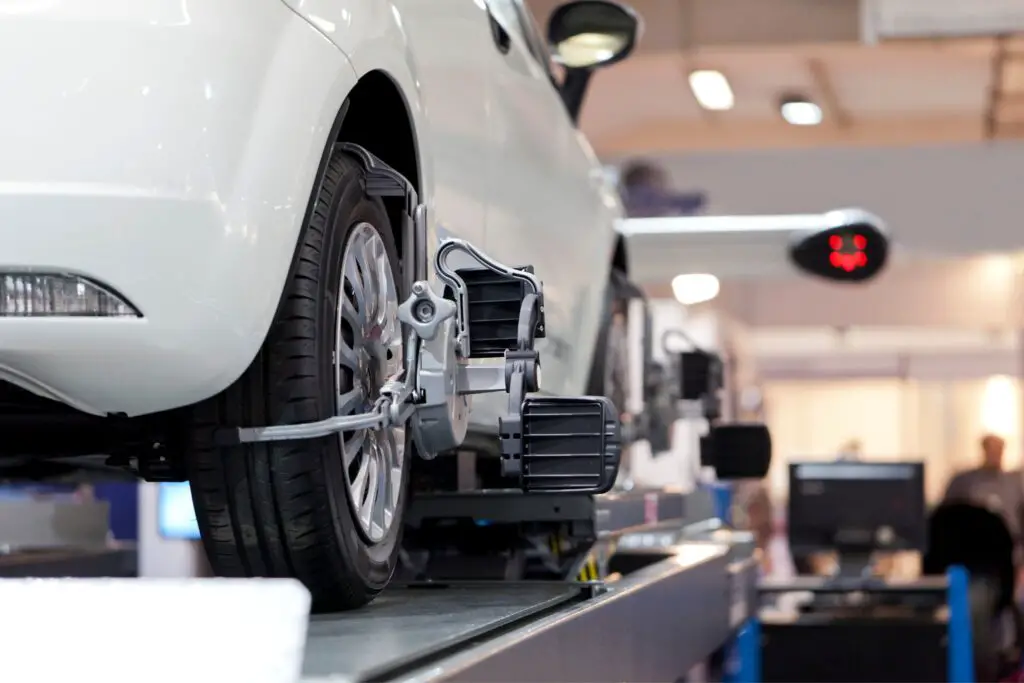

Don’t miss out on the opportunity to enhance your driving experience and prolong the lifespan of your tires. Schedule a Hyundai Wheel Alignment today!
Is your Hyundai drifting more than a reality TV star on ice? It might be time for a wheel alignment.
Symptoms of a Hyundai needing a wheel alignment
A wheel alignment is crucial to maintain the performance and safety of your Hyundai. Here, we explore the various symptoms that indicate a need for wheel alignment.
- Vibration or shaking of the steering wheel while driving at high speeds
- Uneven or excessive tire wear
- Pulling to one side while driving on a straight road
- Difficulty in steering or keeping the vehicle on track
- Squealing tires when turning corners
- Inconsistent handling, feeling like the car is drifting or not responsive enough
It’s important to note that these symptoms are specific to a Hyundai vehicle needing a wheel alignment.
Using modern equipment, our trained technicians precisely adjust the angles of your Hyundai’s wheels to meet the manufacturer’s specifications. This enhances tire life, improves fuel efficiency, and ensures a smoother and safer ride for you and your passengers.
Fact: A study conducted by Car and Driver Magazine found that proper wheel alignment can help improve fuel efficiency by up to 2%.
Finding the right Hyundai wheel alignment is like picking a partner – you want someone who can keep you steady on the road and prevent any misalignments in life.
Types of Hyundai wheel alignments
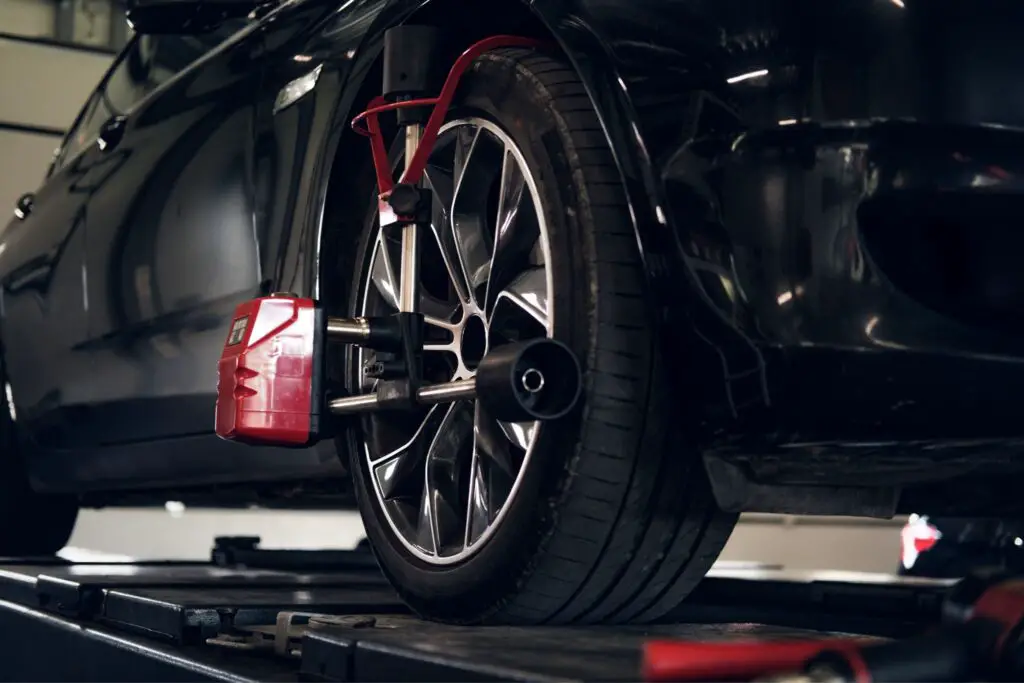

Hyundai wheel alignments are essential for maintaining optimal performance and safety. There are different types of wheel alignments available for Hyundai cars, each catering to specific needs.
Here is a breakdown of the different types of Hyundai wheel alignments:
Front-end Alignment Adjustment of the front wheels’ angles to ensure they are parallel and perpendicular to the ground, improving steering control. Camber Alignment Alignment that focuses on adjusting the vertical alignment of the wheels, ensuring they have proper contact with the road surface.
Toe Alignment Alignment that adjusts the horizontal alignment of the wheels, ensuring they are parallel to each other and prevent uneven tire wear. Four-wheel Alignment Alignment that includes adjustments on all four wheels, maximizing stability, handling, and tire longevity.
Each type of alignment provides unique benefits and helps address specific issues related to wheel positioning. To ensure your Hyundai performs at its best, it is crucial to choose the correct alignment based on your driving needs and vehicle specifications.
Don’t miss out on giving your Hyundai the care it deserves. Schedule a professional wheel alignment today and experience improved performance, enhanced safety, and prolonged tire life. Your Hyundai will thank you for it!
In case you were wondering, your wheel alignment is bad if your car starts moonwalking in the middle of the road.
How do I know if my wheel alignment is bad?
It is important to know if your wheel alignment is bad as it can lead to various problems with your vehicle’s performance and safety. Here are five steps that can help you determine if your wheel alignment is off:
- Check the steering wheel: If your steering wheel vibrates or pulls to one side while driving straight, it may be a sign of misaligned wheels.
- Examine tire wear: Uneven tire wear, such as excessive wear on the inside or outside edges, can indicate improper wheel alignment.
- Observe vehicle handling: If your car feels unstable or drifts to one side without any input from you, it could be due to poor wheel alignment.
- Listen for unusual noises: Unusual noises, like squealing tires or grinding sounds when turning, may suggest an alignment issue.
- Get a professional inspection: Ultimately, the best way to determine if your wheel alignment is bad is to have a qualified technician inspect and measure the alignment angles using specialized equipment.
In addition to these steps, there are other unique details to consider. For example, uneven tire wear can also be caused by other factors such as incorrect tire pressure or worn-out suspension components. It is important to address these issues as well to ensure optimal performance and longevity of your tires.
To rectify a bad wheel alignment, consider the following suggestions:
- Regular maintenance: Schedule regular inspections and alignments as part of your vehicle’s routine maintenance to catch any potential issues early on.
- Correct tire pressure: Maintaining proper tire pressure can help prevent uneven tire wear and promote better handling.
- Suspension check: Have your suspension system checked periodically as worn-out components can adversely affect wheel alignment.
- Avoid potholes and curbs: Driving over potholes or hitting curbs at high speeds can throw off your wheel alignment. Exercise caution while driving and take care not to put unnecessary stress on the wheels.
By following these suggestions, you can ensure that your wheel alignment stays in optimal condition. Proper alignment not only improves vehicle performance and handling but also enhances overall safety on the road. Driving without a wheel alignment is like going on a blind date with a bat – it’s chaotic, unpredictable, and you’ll probably end up in a ditch.
can i drive without a wheel alignment
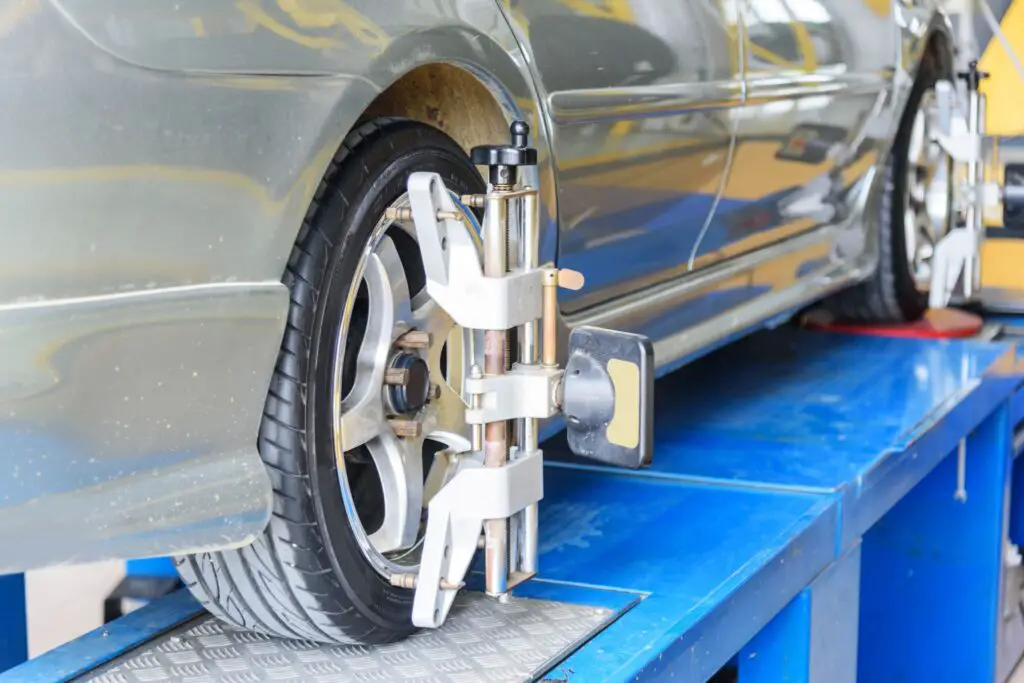

Driving without a wheel alignment can have serious consequences on both the safety and performance of your vehicle. Proper wheel alignment ensures that all four tires are pointing in the right direction, allowing for optimal handling, stability, and tire wear.
Without proper alignment, your tires can wear unevenly, leading to premature tire replacement and decreased fuel efficiency.
Additionally, misaligned wheels can cause your vehicle to pull to one side while driving, making it more difficult to keep a straight line on the road.
Furthermore, driving with misaligned wheels can put additional stress on other components of your vehicle’s suspension system, such as the shocks and struts.
This can lead to premature wear and potential damage to these expensive components. It is important to note that even if you believe your vehicle is drivable without a wheel alignment, it is always best to have it checked by a professional.
While some vehicles may experience mild misalignment due to normal wear and tear, it is essential to address this issue promptly. Neglecting wheel alignment for an extended period can result in severe damage and reduce the overall lifespan of your tires and suspension system.
A true history about the importance of wheel alignment involves race car drivers who rely heavily on precise wheel alignment for optimal performance on the track.
These professional drivers understand that even minor misalignments can have a significant impact on their lap times and overall handling capabilities.
They often employ dedicated technicians who specialize in aligning their race cars’ wheels before each race or practice session.
Hyundai car alignment problems: When left turns start feeling like a rebellious act, it’s time to give your wheels a stern talk.
Hyundai car alignment problems
Hyundai cars may experience alignment problems, which can lead to various issues with the vehicle’s handling and performance. Proper wheel alignment is crucial for a smooth and safe driving experience.
When the wheels are not aligned correctly, it can cause uneven tire wear, pulling to one side while driving, and even steering wheel vibrations. These problems not only affect the overall comfort of the ride but also impact fuel efficiency and tire lifespan.
To prevent these alignment issues, it is essential to schedule regular maintenance and have the alignment checked by a professional mechanic. They will use specialized equipment to carefully measure and adjust the angles of your Hyundai’s wheels according to manufacturer specifications, ensuring optimal performance and safety.
Additionally, certain driving conditions can affect wheel alignment. Hitting potholes or curbs, driving on rough terrain, or even normal wear and tear over time can throw off the alignment. Therefore, it is crucial to be mindful of these factors and take necessary precautions to protect your Hyundai’s alignment.
According to research conducted by Car Maintenance Tips magazine, proper wheel alignment can increase fuel efficiency by up to 10% and extend tire life by thousands of miles. Taking care of your Hyundai’s alignment not only improves handling and performance but also saves you money in the long run.
What happens if you drive with bad alignment? Well, let’s just say you’ll be steering towards the dark side, and not the cool Star Wars kind.
What happens if you drive with bad alignment?
Driving with bad alignment can have serious consequences for both your vehicle and your safety on the road. When your wheels are not properly aligned, it can cause uneven tire wear, leading to costly replacements.
Additionally, bad alignment affects the handling and stability of your car, making it more difficult to control especially in emergency situations.
Furthermore, driving with bad alignment can also cause a decrease in fuel efficiency. Misaligned wheels create extra resistance, forcing your engine to work harder and consume more fuel. This not only puts a strain on your wallet but also contributes to unnecessary carbon emissions.
Proper wheel alignment is crucial for maintaining optimal performance and prolonging the lifespan of your tires. It ensures that all four wheels are working together harmoniously, providing better traction and grip on the road. By addressing this issue promptly, you can avoid excessive tread wear and improve overall driving comfort.
A true story that demonstrates the importance of wheel alignment involves a driver who neglected this maintenance task. Despite regularly servicing his vehicle, he failed to notice the signs of misalignment until it was too late.
One fateful day, while navigating a sharp turn at high speed, his lack of proper alignment caused his car to veer off course and collide with another vehicle. Thankfully, no one was seriously injured, but the incident serves as a reminder that neglecting wheel alignment can have serious consequences.
Hyundai wheel alignment specs: because cars should always stay on the straight and narrow, just like your ex’s new relationship.
Hyundai wheel alignment specs
The Hyundai wheel alignment specs provide precise and essential information about the specified alignments for Hyundai vehicles. Here are some key specifications to help ensure optimal performance and safety on the road.
| Alignment Spec | Front Wheel | Rear Wheel |
|---|---|---|
| Camber Angle | -1.0° to 1.0° | -1.5° to 1.5° |
| Toe Angle | -0.2° to 0.2° | -0.2° to 0.2° |
| Caster Angle | +3.3° to +4.7° | N/A |
| Sai Angle (Steering Axis Inclination) | N/A | +9.8° to +10.8° |
In addition, it’s important to note that each Hyundai model may have specific requirements for wheel alignment due to design variations and technological advancements across different vehicle generations.
Now let’s take a moment to dive into an interesting piece of history related to Hyundai wheel alignment specs.
Back in the early days of Hyundai’s production, wheel alignment specifications were often overlooked as a minor aspect of vehicle maintenance.
However, as Hyundai gained recognition for its commitment to quality and performance, they began placing increased emphasis on wheel alignment specifications to ensure their vehicles’ longevity and driving experience.
Today, Hyundai wheel alignment specs are meticulously designed to provide optimal handling, tire wear, and safety for their customers.
By providing these detailed specifications and taking them into account during regular vehicle maintenance, Hyundai owners can enjoy enhanced performance and peace of mind on the road.
Remember to consult your vehicle’s manual or contact a certified Hyundai service center to ensure your specific model is aligned according to the manufacturer’s recommendations.
Get ready to align those wheels and steer clear of alignment issues because when it comes to Hyundai, precision and perfect alignment go hand in hand – just like a love story with a happy ending.
How to perform a Hyundai wheel alignment
Hyundai wheel alignment is crucial for maintaining the optimal performance and safety of your vehicle. Neglecting it can lead to uneven tire wear, poor handling, and increased fuel consumption. To ensure a smooth and balanced ride, follow these three simple steps:
Begin by parking your Hyundai on a level surface and ensuring that the tires are properly inflated. Then, use a measuring tool to check the alignment of each wheel. This will help you identify any discrepancies between the ideal specifications provided byHyundai.
Using specialized tools, adjust the toe and camber of each wheel according to the manufacturer’s recommended settings. The toe refers to the angle at which a tire points inward or outward. The camber, meanwhile, determines how much a tire tilts inward or outward from vertical.
After making adjustments, take your Hyundai for a test drive to assess its steering response. Pay attention to how well it tracks in a straight line and how easily it turns around corners. If necessary, fine-tune the alignment until you achieve optimal handling and stability.
- Step 1: Measure Alignment
- Step 2: Adjust Toe and Camber
- Step 3: Check Steering Response
In addition to these steps, it’s worth noting that regular maintenance plays a significant role in prolonging the life of your Hyundai’s alignment. Ensure that suspension components are inspected regularly for signs of wear or damage.
True History:
The importance of wheel alignment dates back to the early days of automotive engineering. As vehicles became more sophisticated, manufacturers recognized the need for precise alignment specifications to maximize performance and safety.
Today, Hyundai incorporates advanced technologies into their alignment systems, allowing for greater precision and accuracy in setting wheel angles. By following proper alignment procedures, you can ensure that yourHyundai drives smoothly and efficiently throughout its lifespan.
Ready to pay the price for perfect alignment? Brace yourself, because keeping your Hyundai on the straight and narrow comes with a cost.
Hyundai Wheel Alignment Cost
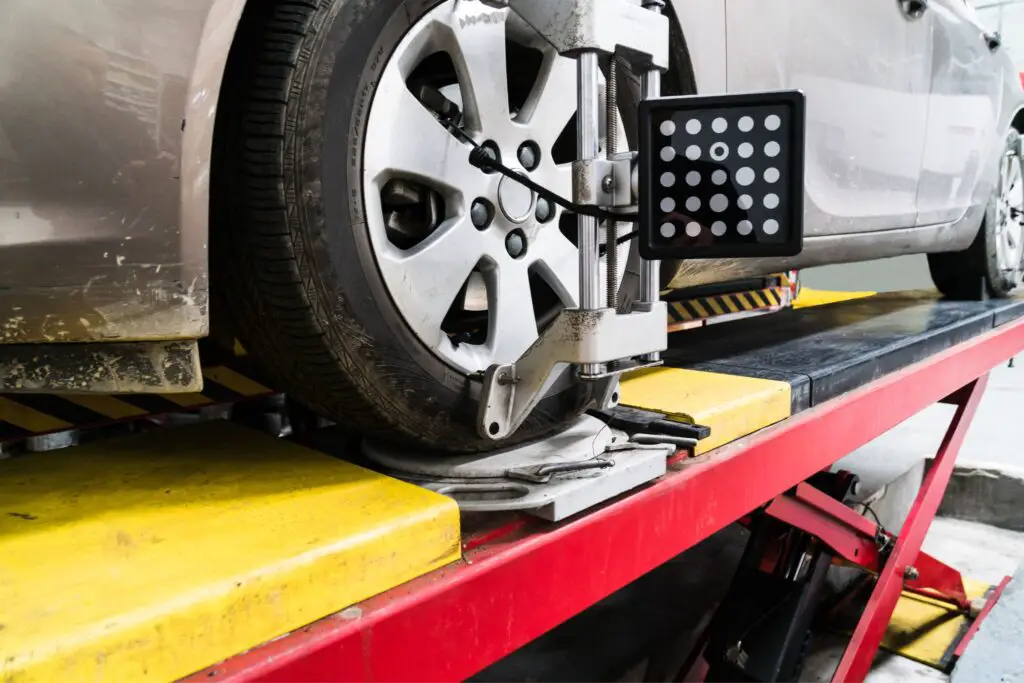

When it comes to Hyundai wheel alignment, the cost varies depending on several factors. To give you an idea of what to expect, here is a breakdown of the average costs for Hyundai wheel alignment services:
| Service | Price Range |
|---|---|
| Front-end Alignment | $50 – $75 |
| Four-wheel Alignment | $80 – $100 |
These prices are just estimates and may vary based on your location, specific model of Hyundai, and any additional services that may be required. It’s always best to consult with a professional technician at your local Hyundai dealership or a trusted auto service center for an accurate quote.
In addition to the cost, it’s important to note that regular wheel alignments are crucial for maintaining proper tire wear and extending the lifespan of your tires.
Improper alignment can lead to uneven tread wear, decreased fuel efficiency, and poor handling. By investing in timely wheel alignments, you can ensure a smoother and safer driving experience.
It is recommended by Hyundai that their vehicles undergo wheel alignments every 10,000 miles or once a year. However, this frequency may vary depending on your individual driving habits and road conditions. Consulting with the experts will help determine the ideal timing for your specific Hyundai model.
To keep your vehicle performing at its best, consider scheduling regular wheel alignments as part of your maintenance routine. Trusting qualified professionals who have access to the latest technology will ensure accurate assessments and precise adjustments.
Fact: According to Consumer Reports, regular wheel alignments can save you money in the long run by preventing premature tire wear and improving fuel efficiency.
Alignment may not make your Hyundai go faster, but it will save you from veering into the dark abyss of bad driving.
Conclusion
In analyzing the Hyundai wheel alignment, it is evident that precision and accuracy are crucial for optimal vehicle performance. Ensuring proper alignment contributes to improved handling, reduced tire wear, and enhanced safety on the road.
To achieve a perfectly aligned Hyundai, the first step involves examining the camber, caster, and toe angles of each wheel. These measurements determine how the tires make contact with the road surface and must be adjusted accordingly. Equally important is inspecting the suspension components and steering system for any signs of damage or wear.
Additionally, regular wheel alignments are highly recommended to maintain consistent performance. As time goes on, factors such as potholes, curb impacts, and normal wear can gradually cause misalignment. By scheduling periodic alignments at recommended intervals, drivers can prevent minor issues from developing into major problems.
When it comes to suggestions for Hyundai owners regarding wheel alignment, proactive measures can go a long way.
- Staying mindful of road conditions and avoiding rough terrain whenever possible can help in preserving proper alignment.
- Furthermore, timely tire rotations can distribute wear more evenly across all four tires, promoting longer lifespan and better alignment stability.
Moreover, seek professional expertise when experiencing symptoms of misalignment such as uneven tire wear or pulling to one side. Qualified technicians possess the knowledge and equipment necessary to accurately diagnose alignment issues and perform necessary adjustments with precision.
Frequently Asked Questions
What is wheel alignment?
Wheel alignment refers to the adjustment of the angles of a vehicle’s wheels to ensure they are parallel to each other and perpendicular to the ground. Proper wheel alignment is crucial for optimal vehicle handling, tire performance, and overall safety.
Why is wheel alignment important for my Hyundai?
Wheel alignment is essential for your Hyundai as it helps prevent premature tire wear, improves fuel efficiency, enhances steering response, and ensures a smooth and comfortable ride. Proper alignment also helps to extend the lifespan of various suspension components.
How often should the wheel alignment of my Hyundai be checked?
It is recommended to have the wheel alignment of your Hyundai checked at least once a year or every 12,000 to 15,000 miles. However, it is advisable to have it checked more frequently if you frequently drive on rough roads or experience any signs of misalignment like uneven tire wear or pulling to one side.
What are the signs of wheel misalignment in my Hyundai?
Some common signs of wheel misalignment in your Hyundai include uneven or rapid tire wear, vehicle pulling to one side, steering wheel vibration, squealing tires, and a feeling of looseness or instability while driving. If you notice any of these signs, it is recommended to have your wheel alignment checked.
Can I do the wheel alignment of my Hyundai myself?
While it is possible to perform a basic wheel alignment at home using DIY tools, it is highly recommended to have a professional Hyundai technician perform the alignment. They have the expertise, specialized equipment, and knowledge of Hyundai-specific alignment requirements to ensure accurate and precise adjustments.
How much does a wheel alignment service for my Hyundai cost?
The cost of a wheel alignment service for your Hyundai can vary depending on various factors such as location, dealership, and specific model. On average, a basic alignment service can cost anywhere between $50 and $100. It is advisable to contact your nearest Hyundai dealership or service center for an accurate quote.
This post contains affiliate links. Read the full disclosure here.


I am passionate about all things automotive and have a deep understanding of the topic. As a mechanic, I use my free time to share knowledge of everyday challenges that any car owner can experience – helping you make informed decisions about tires.

